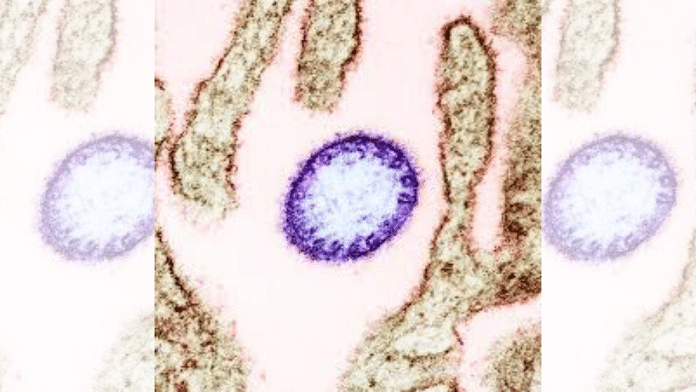Gennova, a subsidiary of Emcure Pharmaceuticals, which has been working on a self-amplifying mRNA (saRNA) vaccine against the virus, announced Tuesday a collaboration with the Coalition for Epidemic Preparedness Innovations (CEPI) and said it will receive up to USD 13.38 million to accelerate the vaccine development.
CEPI is a global partnership between public, private, philanthropic, and civil organisations that aims to accelerate vaccine development against epidemic threats.
mRNA vaccines such as those brought out by Pfizer and Moderna during the Covid pandemic, use the body’s machinery to make antigenic protein rather than injecting the antigen directly into the body. saRNA vaccines, however, work by giving the body instructions to replicate mRNA needed to create the desired antigen, potentially enhancing the immune response with lower doses compared to existing mRNA vaccines.
The biopharma firm has declared that as part of the collaboration, preclinical and phase-1 vaccine tests will be done in India.
Gennova will also team up with US-based Houston Methodist Research Institute (HMRI), a CEPI partner, to use their cutting-edge artificial intelligence technology to optimise the properties of proteins derived from the virus that could stimulate the immune system and serve as optimal vaccine targets for the company to investigate in the lab and in the clinic.
Dr Sanjay Singh, chief executive of Gennova Biopharmaceuticals, called the collaboration a significant advancement in the fight against the Nipah virus. “By harnessing the cutting-edge capabilities of our saRNA platform, we are committed to developing a revolutionary next-generation vaccine. This partnership not only sets a new standard for the rapid development of mRNA vaccines but also ensures equitable access and strengthens global health security,” he said.
Independent scientists ThePrint spoke to called the development a significant move, saying that the vaccine should be quickly rolled out for the affected geographies, those at high risk of exposure, healthcare personnel or those in close contact with the infected persons, in case of an outbreak.
“For a pathogen like Nipah which is highly fatal but geographically limited, a vaccine, however, can be useful only if it is capable of generating antibodies in people within days of administration,” said Dr R R Gangakhedkar, epidemiologist and formerly chief scientist with the Indian Council of Medical Research (ICMR).
Overall, while evidence of the Nipah virus has been established in several animals and across various countries, instances of it infecting humans has been reported in Malaysia, Singapore, Bangladesh and India, after the first outbreak in Malaysia 26 years ago that spread to Singapore.
In India, the first Nipah virus outbreak was reported in West Bengal in 2001. Since 2018, Kerala has reported an outbreak of the disease almost every year.
In Kerala’s first Nipah outbreak, the pathogen killed 17 out of 18 people infected, marking a fatality rate of 94.4 percent.
There are two strains of the Nipah virus—the Malaysia strain and the Bangladesh strain, which has been causing outbreaks in India. The Bangladesh strain, evidence shows, is more severe than the Malaysia one—resulting in a higher number of fatalities.
In 2022, the World Health Organization (WHO) put Nipah virus on its list of priority pathogens for the first time, and scientists have been concerned about the virus’s potential to cause a global pandemic as it is capable of human-to-human transmission.
Nipah is so deadly that several governments classify it as a bioterrorism threat, and only a handful of laboratories globally are allowed to study it.
There are still no approved human vaccines or treatments for Nipah, but one—ChAdOx1 NipahB—entered its first human trial last year.
This vaccine, developed by Oxford University’s Pandemic Sciences Institute, uses the same viral vector vaccine platform used to make the Oxford/AstraZeneca Covid-19 vaccine.
In August 2023, CEPI had initially provided up to $3.6 million to support the optimisation of Gennova’s saRNA-platform technology to develop vaccine candidates against unknown pathogenic threats, also referred to as Disease X.
The initial tranche of funding was part of CEPI’s programme to support novel RNA vaccine platform technologies for emerging and select endemic infectious diseases, which could offer substantial advantages over existing mRNA technologies, such as multivalency, improved immunogenicity, storage and stability, productivity, response time, and cost-effectiveness.
“With no vaccines or specific therapeutics approved for human use against Nipah, CEPI is leading the charge to protect the world against this deadly virus committing over $100 million to its Nipah programmes and advancing the first ever Nipah vaccine candidates into Phase 1 studies and through to completion,” Dr Kent Kester, executive director of Vaccine Research and Development at CEPI said.
“Gennova’s work will not only help establish the suitability of the saRNA platform for use against Nipah but also its suitability as part of a wider group of RNA technologies that could enable rapid responses to future Disease X threats, potentially within 100 days of identification,” said Kester.
(Edited by Insha Jalil Waziri)








